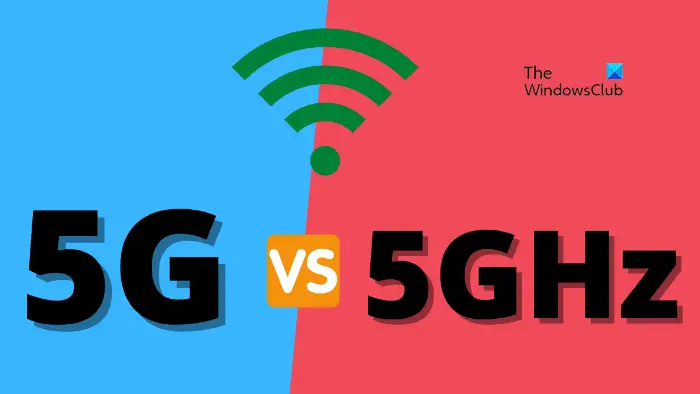5G and 5 GHz Wi-Fi are wireless Internet connectivity devices. These two have similar names, similar techniques but different attributes. The 5G stands for the fifth generation of the cellular phone family whereas 5GHz measures the frequency in gigahertz. In this walk of technology-savvy life, we are experiencing a new way of doing things every now and then. We have smartphones, smart technology but are we smart enough to use them correctly? This post will illustrate the difference between 5G and 5 GHz Wi-Fi.

Difference between 5G and 5 GHz Wi-Fi
5G and 5 GHz Wi-Fi is a new range of wireless connections, famous for a faster network in a shorter range. Both 5G and 5GHz Wi-Fi provides an incredibly faster internet connection as compared to past generation networks. The previously used WiFi devices had an average range of 50-75 feet, which has been decreased to 20-50 feet with 5 GHz technology. The same short-range aspect comes with cellular 5G. Let us know the difference between 5G and 5 GHz Wi-Fi.
What is 5 GHz?
WiFi is one of the most common wireless devices used nowadays. Most of the Wi-Fi uses a frequency of 2.4 GHz that has a longer spectrum. The newly introduced bandwidth for WiFi connection is 5 GHz. The frequency of 5 GHz offers a faster network in a shorter range. The modern router comes with a dual bandwidth to support both 2.4 GHz and 5 GHz. It is misleading to name your WiFi connection 5G, as it is nowhere associated with cellular 5G rather it simply means 5GHz.
We are always looking an innovative and faster network services that are the main reason behind the emergence of 5 GHz WiFi technology. The 2.4 GHz WiFi connection still has some advantages over the 5GHz connections. The longer radio waves and broader spectrum supported connectivity between the walls as well as on the longer distance. On other hand, 5GHz Wi-Fi prevents connection overlapping and network congestion. Hence this new technology is best suited for in-house connections.
Read: Difference between Wi-Fi 6E and Wi-Fi 6.
What is 5G?
In the family of cellular phones ‘G” stands for generation and therefore every generation of the network has a number followed by G. Similar to 5 GHz, 5 G also offers faster internet connectivity with a shorter range. It is important to know that 5G has no connection with 5GHz WiFi. These are just two similar-looking terms. It utilizes high frequency but not necessarily 5 GHz to provide a faster network.
In the future, 5G will come up with a dubbed coverage layer for television connections. It is also predicted that 5G will provide the framework for the technical systems of driverless cars. Never the less we will soon experience all our essential devices connected to this advanced faster version of the network.
Read: How to secure your WiFi against FragAttacks?
5G could use 5 GHz Wi-Fi
5G is a set up of cellular phones and as mentioned above 5G network connection may or may not uses 5 GHz frequency depending upon the usage. It is also essential to note that many of us use our WiFi network connection on our mobile devices. In such cases, 5G cellular will use a 5 GHz WiFi connection. This implies that the 5G can be implemented on the 5GHz spectrum.
Read: How to switch between 2.4 GHz and 5 GHz Wi-Fi bands?
Technology
The technology used for both 5G and 5GHz is entirely different therefore both the devices cannot intercommunicate with each other. The devices have distinct chipsets or radios. It is also not possible to share any information or data between both devices. The cellular 5-G range has a manageable spectrum along with a feature of overlapping cells which are lacking in 5 GHz WiFi.
Though both the technologies have a short-range, 5G cellular have larger coverage than a 5GHz Wi-Fi. The 5GHz WiFi is most suitable for more people in a closed area like concerts, shows, etc.
Hope this post helped you in knowing the basic differences.
Leave a Reply